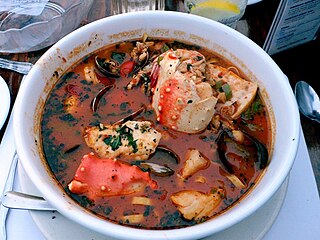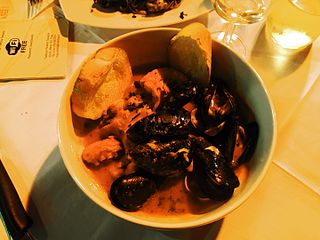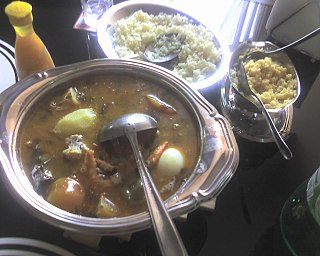Kakavia (Greek : κακαβιά) is a Greek fish soup.
Its name comes from the kakavi, the tripod cooking pot used by ancient Ionian fishermen. [1] Kakavia has been described as "the most ancient of Greek fish soups", and related to lineage to the French bouillabaisse; like that stew, kakavia is made with a flexible variety of fish and is associated with fishing villages. [2]
It was traditionally made from the smallest fish caught by fishermen, along with olive oil, onions, and saffron. [1]
One modern recipe calls for filleted and chunked whitefish (such as cod, goliath grouper, or snapper), prawns, fish or vegetable stock, tomatoes, onions, potatoes, olive oil, lemon juice, and a garnish of flatleaf (Italian) parsley. [1] Another calls for three or four kinds of fish cleaned and sliced for poaching (bass, cod, hake, haddock, halibut, trout, pollock, snapper, rockfish, whiting), plus shrimp and perhaps lobster or scallops, along with onions, scallions, or leeks; olive oil; tomato; stalk fennel or celery; fresh parsley; fresh thyme; bay leaf; ground black pepper; white wine and water; and toasted croutons. [2]
Kakavia is similar to other types of Mediterranean fish stew, such as the French bouillabaisse, Italian cacciucco, Spanish zarzuela, and Portuguese caldeirada. [3]

Turkish cuisine is largely the heritage of Ottoman cuisine, Seljuk cuisine and the Turkish diaspora. Turkish cuisine with traditional Turkic elements such as yogurt, ayran, kaymak, exerts and gains influences to and from Mediterranean, Balkan, Middle Eastern, Central Asian and Eastern European cuisines.

Bouillabaisse is a traditional Provençal fish soup originating in the port city of Marseille. The word is originally a compound of the two Provençal verbs bolhir and abaissar.

Mediterranean cuisine is the food and methods of preparation used by the people of the Mediterranean Basin. The idea of a Mediterranean cuisine originates with the cookery writer Elizabeth David's book, A Book of Mediterranean Food (1950), and was amplified by other writers working in English.

Cioppino is a fish stew originating in San Francisco, California, an Italian-American cuisine related to various fish soups in Italian cuisine.

Sofrito, sofregit, soffritto, or refogado is a basic preparation in Mediterranean, Latin American, Spanish, Italian and Portuguese cooking. It typically consists of aromatic ingredients cut into small pieces and sautéed or braised in cooking oil for a long period of time over a low heat.

Cacciucco is an Italian fish stew native to the western coastal towns of Tuscany. It is especially associated with the port city of Livorno, in Tuscany, and the town of Viareggio north of it.

Caldeirada is a Portuguese and Galician fish stew consisting of a wide variety of fish and potatoes, along with other ingredients. A fishermen's stew, the dish has been described as "a fish muddle that varies from town to town and depends on what the fishermen have managed to catch."

Tunisian cuisine, the cuisine of Tunisia, consists of the cooking traditions, ingredients, recipes and techniques developed in Tunisia since antiquity. It is mainly a blend of Arab, Mediterranean, Punic, and Berber cuisine. Historically, Tunisian cuisine witnessed influence and exchanges with many cultures and nations like Italians, Andalusians, French and Arabs.

Many cuisines feature eggplant salads and appetizers.

Neapolitan cuisine has ancient historical roots that date back to the Greco-Roman period, which was enriched over the centuries by the influence of the different cultures that controlled Naples and its kingdoms, such as that of Aragon and France.

Squid is eaten in many cuisines; in English, the culinary name calamari is often used for squid dishes. There are many ways to prepare and cook squid. Fried squid is common in the Mediterranean. In New Zealand, Australia, the United States, Canada, and South Africa, it is sold in fish and chip shops, and steakhouses. In Britain, it can be found in Mediterranean 'calamari' or Asian 'salt and pepper fried squid' forms in various establishments, often served as a bar snack, street food, or starter.
Psarosoupa is the Greek word for a fish soup, traditional to Greek cuisine. There are several variations on the soup. All include fish and vegetables.

Algerian cuisine includes multiple flavors and influences, reflecting the country's history and position at the crossroads of the Mediterranean.

Mizrahi Jewish cuisine is an assortment of cooking traditions that developed among the Mizrahi Jewish communities of the Middle East, North Africa and Central Asia. Influenced by the diverse local culinary practices of countries such as Morocco, Libya, Egypt, Iraq, Iran, Yemen, and Syria, Mizrahi cuisine prominently features rice, legumes, meats, and an array of spices such as cumin, turmeric, and coriander. Signature dishes include kubbeh (dumplings), pilafs, grilled meats, and stews like hamin.

The Gambia does not actually have its own cuisine; the food that is to be found there stems mostly from neighboring Senegal, whose cuisine is French-influenced. Common ingredients include fish, rice, peanuts, tomato, black-eyed peas, lemon, cassava, cabbage, potato, pumpkin, garden egg, lettuces, rice, couscous, corn, findi, salt, pepper, onion, chili, and various herbs. Oysters are also a popular food from the River Gambia, and are harvested by women.

A stew is a combination of solid food ingredients that have been cooked in liquid and served in the resultant gravy. Ingredients can include any combination of vegetables and may include meat, especially tougher meats suitable for slow-cooking, such as beef, pork, venison, rabbit, lamb, poultry, sausages, and seafood. While water can be used as the stew-cooking liquid, stock is also common. A small amount of red wine or other alcohol is sometimes added for flavour. Seasonings and flavourings may also be added. Stews are typically cooked at a relatively low temperature, allowing flavours to mingle.